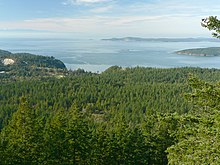Samish
The Samish are an Indian tribe living in what is now Washington State . They live in northwest Washington in the Anacortes and Bellingham area . Culturally they belong to the coastal Salish and speak the Lekwungen dialect; they are closely related to the lummi .
The name is derived from the Skagit word for "hunter".
history
Early history

The earliest human traces date from around 12,000 BC. These are cuts on a Bos bison antiquus , the bones of which were discovered at Ayer Pond on Orcas Island .

The Samish, like most coastal Salish, were only permanent in winter. During the warm season, they were mainly found on the islands towards Vancouver Island and in Puget Sound , especially on the San Juan Islands . Winter villages existed on Samish , Guemes and Fidalgo Island .
Epidemics, population collapse, treaty with the US
In 1847 the comparatively large tribe probably had 2,000 members, but the population collapsed completely as a result of smallpox , flu and measles epidemics , while the Haida and Tsimshian raids from the north further reduced their numbers. At the time of the Treaty of Point Elliott (1855) there were only 150 Samish in a single village. According to the contract, many of them were counted among the Lummi.
While Point Elliott was negotiating a treaty with Washington Territory Governor Isaac Stevens , 113 Samish were present, but two chiefs the Lummi (Chow-its-hoot) and the Lower Skagit (Pateus) signed on their behalf. Since they were not given a reservation, many went to the Lummi or the Swinomish . Most, however, stayed in their homeland.
New Guemes
Because the government took many of them to be Skagit or Swinomish, they only got 6 settlements. The rest of them went to Guemes Island and founded New Guemes, now known as Potlatch Beach. Around 100 Samish lived in the large longhouse there. But they couldn't hold out against the white settlers at the only freshwater spot on the island. By 1912 most of them had left the island. Some of them were among the founding members of the Northwest Federation of American Indians .
Fight for recognition as a tribe
From 1926 the Samish began to appear again as a separate ethnic group, mostly as the Samish Indian Tribe . They gave themselves a constitution and began to keep a membership list. Billie Edwards, the 110-year-old Samish chief and last witness to the Treaty of Point Elliott, was the oldest guest at the treaty ceremony on January 31, 1929. The United States Court of Claims recognized that the Samish were in were to include the Point Elliott contract, but they had already received sufficient benefits.
In 1951 the Samish gave themselves a new constitution. In 1958, the Indian Claims Commission recognized that the Samish had owned Samish Island, the eastern part of Lopez Island, Cypress Island and Fidalgo Island in addition to Guemes Island . The losses from the treaty with the USA covered an even larger area. In 1969 the Samish were not listed again in the list of recognized Indian tribes, probably by mistake.
In 1971 the tribe joined the Small Tribes Organization of Western Washington , which looked after the numerous small tribes in the west of the state in particular. That same year the tribe received $ 5,754.96 in compensation for 37 square kilometers of land expropriated by the Point Elliott Treaty.
In 1979 their application for recognition was denied, but on April 26, 1996 the Samish Indian Nation was recognized as a tribe again.
Todays situation
The leadership of the tribe is taken over by a tribal council. It consists of 11 members. In 1974 the district court recommended the abolition of the so-called Blood Quantum rule, according to which only Samish could be who had a certain number of Indian ancestors.
literature
- Brent D. Galloway: A Phonology, Morphology, and Classified Word List for the Samish Dialect of Straits Salish , Canadian Ethnology Service 1999
- Robert H. Ruby / John A. Brown: A Guide to the Indian Tribes of the Pacific Northwest , University of Oklahoma Press 1992, pp. 178-181
Web links
- Samish Indian Nation
- Samish history from the Samish Nation Cultural Department , archive.org, June 14, 2008
See also
Remarks
- ↑ James Philips: Washington State Place Names , University of Washington Press 1971, p. 185.
- ↑ Meredith Griffith: 14,000-year-old Bison skull found on Orcas X-rayed for stone weapon fragments: New Slideshow , in: The Islands' Sounder, June 10, 2010.
- ↑ The Wenatchee daily world , a daily newspaper, published this photo .